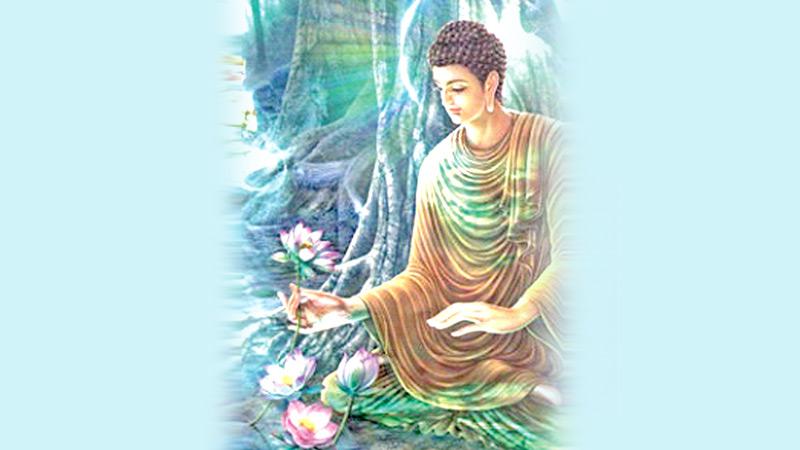
Sakyamuni Gauthama Buddha, the unique being with love and compassion, gave the world a rational analysis of the Truth of Life, gained supreme Enlightenment, came to be identified with Buddhahood discovering the Four Noble Truths.
His first sermon to the five ascetics at Isipatana, Dhammachakkapavattana Sutta which means the establishment of Dhamma - the Four Noble Truths, achieved through His clear vision, intellect knowledge and wisdom.
According to Majjima Nikaya, the Buddha has said to his disciples that He has the capacity of discovering the truths and also proclaiming them to the world. The basic truth - Dukkha and Cessation of Dukkha. The burden of Dukkha arising from craving to be got rid of, by following the Eightfold Path (Arya Astangika Maggo).
This is possible for those who possess an unwavering confidence in the Buddha-Dhamma and Sangha. This threefold refuge is the only safe and sure way to achieve the Supreme Bliss of Nibbana - the end of sansaric journey of births and deaths. The Buddha said, “Nibbana is the highest happiness”. The highest aim of the Buddhist is the attainment of it.
Summit of Perfection
The Buddha never claimed to be a supernatural being. He was the son of human parents. The truth he discovered eternal and the absolute truth was not gained through any external power, but by His own effort. The summit of perfection which He attained with His own endeavours was for the humanity at large without any distinction, race, caste or creed.
The most striking feature was its rationality and moral welfare. Now that the conquest has been made and the summit of bliss has been reached, the next step was its propagation not by force, but by mere conviction, and its appeal to the mankind. For this there were His disciples - Sangha, to spread the doctrine. The disciples followed with utmost faith and attained Arahantship setting in motion the Sangha Sasana.
The Sangha grew in numbers. The Sakyamuni addressed the disciples to spread the doctrine “Go forth Bhikkhus into the world take the message of Dhamma, explain to them what I have taught you for the well-being of the majority”. Then the Buddha Himself calm and serene, walked on dusty rough roads in North India preaching His doctrine the Buddha’s way of life and His Akalika Dhamma.
The Buddha all wise and compassionate, out of deep love for humanity made Him teach His message to one and all.
He had a life of incessant activity. He encouraged endlessly trying to offer His wisdom to the people. His Dhamma was a practical religion laying emphasis on morality and right living. The cardinal teachings were given in the Four Noble Truths.
He saw life in reality from every angle. He saw a change, the law of cause and effect Kamma regaining supreme over the entire universe.
He saw the nature of Sansara in its true perspective and emphasised the middle path as the golden path which is a simple and straight path.
The greatness of life led by Him and the nobility of His teachings appealed to many and his doctrine of Dhamma, Ahimsa and Metta illumined those lives. It encouraged learning, advancement of knowledge providing free scope to intellectual activities. His words of compassion came as a blessing to thousands of people who listened to His Dhamma in Jambudeepa.
Zenith of her glory
Wherever the Buddha’s feet touched the soil of India, Buddhism gained a foothold. It is said that India reached the zenith of her glory during Buddha’s time.
Till the age of 80, the Buddha spent all His time journeying in the kingdoms of North India, the present Nepal, Bihar, Bengal and Uttara Pradesh.
The language used by the Master was probably, widely understood by the natives at that time. He preached His absolute Dhamma with His disciples accompanying Him.
The oral tradition was preserved by the Sangha, the guiding force behind the activities of the kings and the people. The active pursuit of Dhamma by the royalty helped Buddhism to make great headway.
His teachings, the Dhamma found support among the many Kshatriyas as opposed to Brahminism who claimed special powers considering themselves socially superior. This pride and aristocracy of Brahminism prevalent at the time favoured the Buddhist movement.
The caste distinction and its strict adherence, was never found in Buddhism. Hatred towards none emphasised in Buddhism with sayings - “Never in this world does hatred cease by hatred, hatred wanes by love”, made people lay all hopes in Buddhism.
